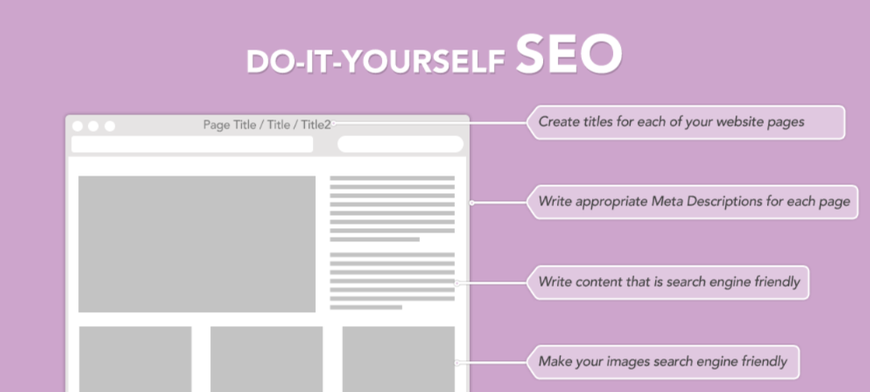Search engines like Google are the primary way in which your web site gets found by customers and interested parties. So, helping search engines find you is absolutely critical to your ability to build traffic to your site. The process of getting search engines to notice your site and report it in the search results is called Search Engine Optimisation, or SEO for short.
SEO is everything to do with managing how well and how high up you appear in the search results when a potential customer types in keywords relevant to your site. People rarely go beyond the first page of results, so your aim is to get into the first twenty search results for your keywords.
To clarify, this is different from being placed in the advertising sections of the search engine results page, ie, the ones in yellow on top, or in the right-hand column, of a search results page on Google. To appear there, you have to pay for a Google AdWords campaign. That is a separate discussion. Below the ads are called the “organic” search results, the unpaid ones. You want to be as high on that list as possible, that is the purpose of SEO.
Since over 85% of searches are done on Google, we will focus on Google in this primer on SEO. Here are some guidelines to consider.
1. Identify your keywords
This is THE most important step, so we’ll go in depth here. Think about your business and your site content. What words or phrases are people likely to use when searching for sites like yours? Make a list of these, then go to the Google Keyword Planner and enter your words and phrases into the tool. In order to use the tool you need to create a Google AdWords account which is easy to do and is free.
Type in your preliminary list of keywords, and you will get two important results: search volumes and related searches. The “related searches” results will likely return some keyword options you did not think of, so add a few of those that you think work for you to your short list.
You can also type in the URL of your website in a separate box provided for the same. This allows Google to crawl through your website and identify the most common themes and return a list of keywords that are most likely to be appropriate. (If the results come up with keywords that are not directly related to your business, you may want to re-think the content of your website!)
Competitive vs. Niche Keywords
When you choose the keywords that you wish to optimize for, you can adopt one of two strategies – optimize for competitive keywords or for niche keywords. Some words naturally generate high search volumes and such words usually are of interest to a large number of web sites and hence are highly competitive keywords. For example let’s say you have an online store selling traditional wooden toys from Channapatna, which is a town famous for such toys. The key words “Toys” and “Wooden Toys” have search volumes of 12100 and 590 per month and are labeled as competitive. Now look at the search volumes for the keyword “Channapatna toys”. The volumes are reasonably high at 720 per month and the level of competition is low.
Now you could tune your SEO to the keyword “Toys” and try to get a high ranking and hence a high potential traffic volume from the 12100 searches every month. But you would need to do lots and lots of things better than the other toy web sites in order to earn that high ranking.
If you adopted the niche keyword SEO strategy, you would optimize for “Channapatna toys” and you would stand a good chance of attracting a percentage of the not so high but not so low search volume of 720 per month. In other words, one strategy is to aim for a small share of a large market and the other is to go after a large share of a small market. The choice is yours. Now, let’s explain what to do once you have selected all your keywords.
2. Create titles for each of your website pages
Page titles are what appear at the top of the browser when a page is displayed. It is part of the HTML code for the page. You should include two or three of your keywords which are relevant for that page in the page title. And try to keep the title short, so that it is not cut short by Google in the search results. As a general rule, stick to a max of 65 characters in your titles.
Also, place your keywords early in the title. For example:
"Pure leather handbags, style accessories | Aparna Fashions"
works better than
"Aparna Fashions | Your online store for stylish leather handbags and fashion accessories"
Try to have a unique title that contains some or all of the keywords you have selected for that page. Now do this for all the pages in your site. If you built the site yourself, you should know how to edit and create the page titles. If someone did it for you, give him or her the page titles to enter and upload.
3. Write appropriate Meta Descriptions for each page
Meta descriptions and keywords were originally used by Google as an input into deciding page ranking, but this is no longer the case. Google's various algorithm upgrades, ranging from Panda to Hummingbird in October 2013, have shifted the importance more towards natural content and away from backend manipulation. Meta descriptions however often appear in search results as the snippet below the page title. Because of this, you should think of your meta description as if it’s an ad for the page.
However, search engines are not obliged to use the meta descriptions you have added unless they really do reflect the page’s content correctly. If they don’t, the engines will simply use snippets from the page’s content and this may not always turn out to be in your best interest, depending on which snippet it chooses.
So, make sure that your meta description accurately matches the content of the page it points to. The best way to do this is to ensure that you use the prominent words that actually appear on that page, like your headlines, bullet points, etc. Make sure it is well-crafted and keep within the recommended limit of 150-160 characters to ensure it appears as a full message.
4. Write content that is search engine friendly
Google is smart. It will figure out if your content is of good quality and whether it addresses users’ search queries. So once you have your keywords, go through the copy text on your site and check whether you have used the keywords naturally AND added value and information relating to the keywords. Your content needs to be engaging to visitors, as this helps to build up your page reputation. Google looks at average time spent by visitors to your page, so your content needs to make the visitor want to linger. But if you fill page with irrelevant content, Google will punish you. You need to maintain the relevance by ensuring your keywords are naturally sprinkled throughout the page.
5. Make your images search engine friendly
Search engines cannot “read” images, so you need to associate some text with them to help the engines read the pictures. First of all, give your images descriptive file names. If the image is a picture of a Channapatna wooden toy car, give it the file name “channapatna_wooden_toy_car.jpg” and not some filename auto-generated by the camera.
Secondly, give the image an “Alt Tag”. This is a feature available on the platform you use to build your web site. In event of the image not being displayed, the browser will display the alt tag as text in the space reserved for the image. Also, provide a description of the image. Try to use a relevant keyword in your alt tag and in the description, and keep the description short and accurate.
Finally, keep your image file sizes as low as possible so that page loading time is minimized. Google considers loading time for the page when deciding on your search rank.
6. Carefully build external links to your site
Google measures your web site reputation by the number and quality of external links to your site. But the moment you have a link from a spam site, you risk being taken off the Google directory altogether. Hence it is better to have genuine back links in limited numbers rather than vast numbers of junk links.
So, submit your website for a listing on directories you are familiar with, those pertaining to your industry or trade, perhaps a locality guide, or even wider interest directories. Provide the option for visitors to share your web pages either on social media networks like Twitter or Facebook or to add the URL to social bookmarks like Reddit. In order to earn these shares, you need to have dynamic content on your site such as news feeds, and also have useful content like blogs or white papers that are valuable enough to be shared by visitors.
7. A caveat: do not try to fool Google
There are a bunch of disingenuous techniques called “black hat SEO” which some web sites use to try to get seen as more relevant and reputable than they actually are. NEVER do this, because you stand the risk of being blacklisted completely by Google. For example, do not put keywords into your metatags that are not relevant to the particular page. Do not have gibberish text full of keywords strung together in meaningless sentences. Do not conceal keyword-stuffed text on your site in small size fonts and/or same colour as the background. These are all tricks that Google knows about and will penalise you for.
Now What? Do not expect overnight results
SEO is an extremely important part of marketing your web site. There is no quick SEO solution. Once you start doing SEO, you’ll want to monitor how your site is ranking. You will find the movement sluggish at first. It takes a couple of months for Google to notice what you have done and then move you up the rankings. On your part, keep fine-tuning your SEO and when you do reach Page 1 of search results, do give us a shout by adding a comment below.
The future of SEO
Google is always tweaking or even modifying their search algorithm. The most recent update is called Hummingbird and was rolled out in September 2013. The principles that guide the new update are mobile search, social media, and author reputation. Mobile search will have more speech inputs and hence natural language. Social media and author reputation imply that Google+ will start playing a bigger role in search rankings, and so will the presence of your website and blog on social media networks. But these are the basics of DIY SEO, and they will not change in a hurry.
--------------------
Related Articles
How the Right Title Tags Can Improve the Performance of Your Website




